Clients with disability
On this page
Key findings: Clients with disability, 2020–21
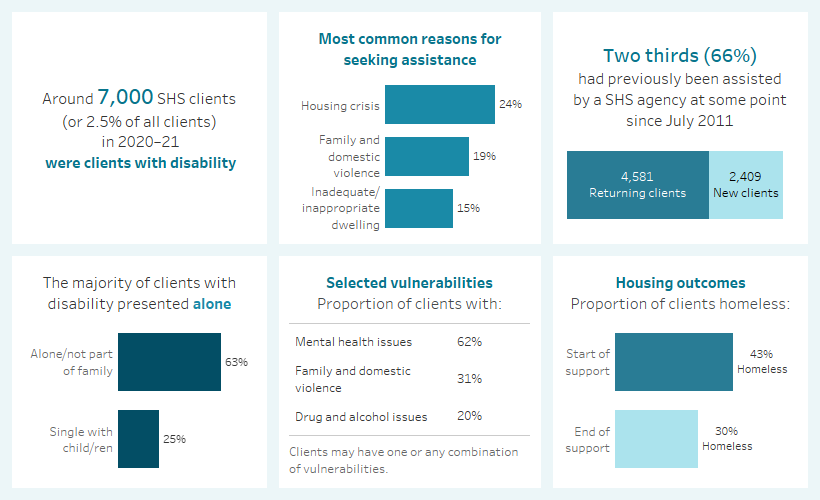
People with disability are a diverse group, with varying types and levels of disability across all socioeconomic and demographic groups (AIHW 2020). Their pathways into and out of homelessness are just as varied, and can be influenced by disability type, location and the level of their disability (Beer et al. 2019). People with disability may have a greater exposure to risk factors associated with homelessness than the general population (Beer et al. 2012). Low income, lack of social support, limited engagement with the labour market, compounded by the need for specialised assistance and services, can leave some people with disability increasingly vulnerable to the risk of homelessness and the negative impact of homelessness.
Timely access to safe, suitable and long-term housing can be critical to the wellbeing of people with disability, providing independence and the ability to participate in social, economic, sporting and cultural life. Housing that meets accessibility requirements, is in close proximity to transport and to quality and affordable support services is also vital for those with disability (COAG 2011).
In 2018, an estimated 1 in 5 Australians (4.4 million people, or 18% of the total population) had disability (ABS 2019), ranging from mild to profound disability; 5.7% of the population (or 1.4 million people) lived with severe or profound disability. Similar to 2006 and 2011, the 2016 Census identified around 5,700 people experiencing homelessness with disability in Australia (defined as people with a need for assistance with core activities) (ABS 2018). People with disability represented 5% of those experiencing homelessness on Census night in 2016.
Reporting clients with disability in the Specialist Homelessness Services Collection (SHSC)
Disability is a challenging concept to measure and there are numerous definitions. The SHSC disability questions aim to establish whether a client has any difficulty and/or need for assistance with 3 core activities (self-care, mobility and communication). These questions are asked of all SHS clients. For the purposes of this report, people who identified that they have a limitation in core activities (and who also reported that they always or sometimes needed assistance with one or more of these core activities) are described as living with a disability. The term ‘severe or profound core activity limitation’ is used to refer to this subgroup of people living with disability in the report.
Data for clients with disability who required assistance may not be comparable across age groups due to differences in the interpretation of the SHSC disability questions. This issue mainly relates to young children, and therefore any comparisons between age groups should be made with caution.
Further details about measuring disability in the SHSC and the definition of a client with severe or profound core activity limitation are provided in the Technical notes.
Client characteristics
In 2020–21, around 7,000 SHS clients always or sometimes needed assistance with core activities (self-care, communication and/or mobility). These clients are described as having severe or profound core activity limitation(s), or throughout this section, as living with disability.
Figure DIS.1: Key demographics, SHS clients with disability, 2020–21
This interactive image describes the characteristics of around 7,000 clients with disability who received SHS support in 2020–21. Most clients were aged 0–9. A quarter were Indigenous. Victoria had the greatest number of clients and the Northern Territory had the highest rate of clients per 10,000 population. The majority of clients had previously been assisted by a SHS agency since July 2011. Most started support at risk of homelessness. Most were in major cities.
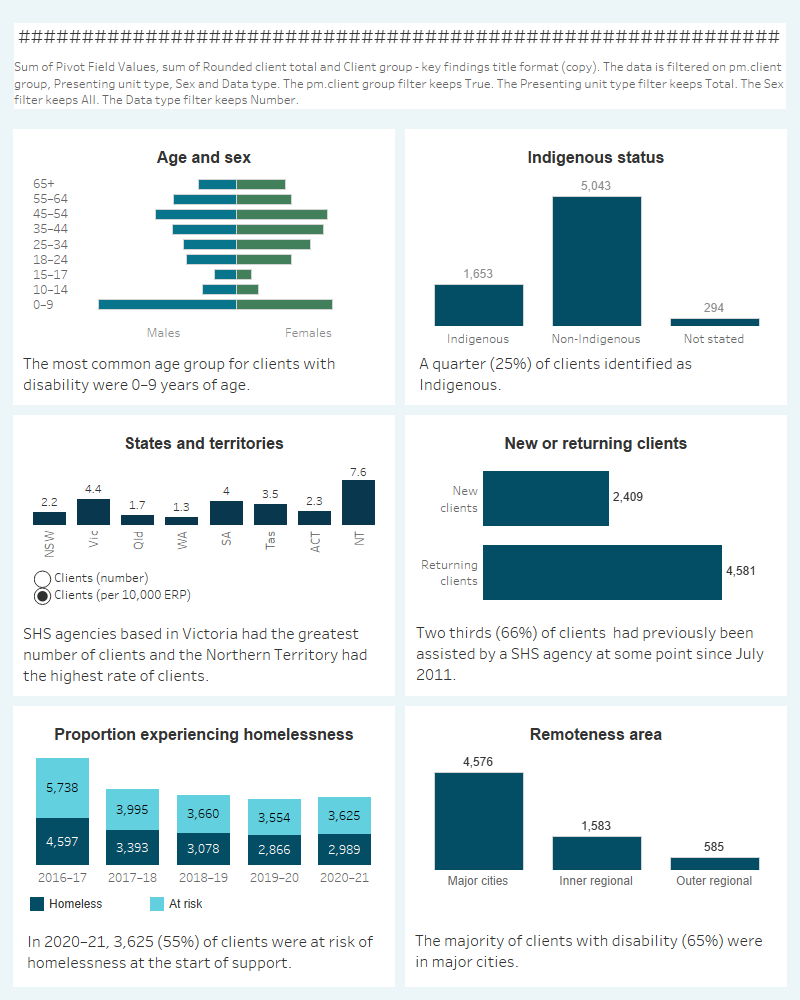
Changes over time
There have been changes in the number of SHS clients with severe or profound disability over time. The number of clients with severe or profound disability increased from around 7,000 clients (2.7% of all SHS clients) in 2013–14 to almost 11,000 clients (3.8% of all SHS clients) in 2016–17 but declined to around 7,000 clients (2.5% of all SHS clients) in 2020–21 (Historical table HIST.DIS).
The pattern of change in the number and rate of SHS clients with severe or profound disability that received services in the states and territories was similar, with declines since peaks around 2016–17 (Historical data table HIST.DIS).
Living arrangements and presenting unit type
In 2020–21, of the almost 7,000 clients with severe or profound disability, the most common living arrangement reported at the beginning of SHS support was living alone (40% or more than 2,700 clients) (Supplementary table CLIENTS.41). The next most common living arrangement was one parent with child/ren (26% or around 1,800) followed by other family (14% or over 900 clients).
The majority of clients with severe or profound disability presented alone (63% or over 4,400 clients) to a SHS agency in 2020–21. This was followed by clients presenting who were single with children (25% or almost 1,800) (Supplementary table CLIENTS.40).
Selected vulnerabilities
Living with disability may not be the only challenge faced by this group of SHS clients. In 2020–21, 74% (or around 4,100) of clients with severe or profound disability (aged 10 and over) reported experiencing one or more selected vulnerabilities: a current mental health issue, problematic drug and/or alcohol use or family and domestic violence (Supplementary table CLIENTS.43) (Figure DIS.2). The remaining 26% (or more than 1,400 clients) did not report any of the selected vulnerabilities.
Figure DIS.2: Clients with disability, by selected vulnerability characteristics, 2020–21
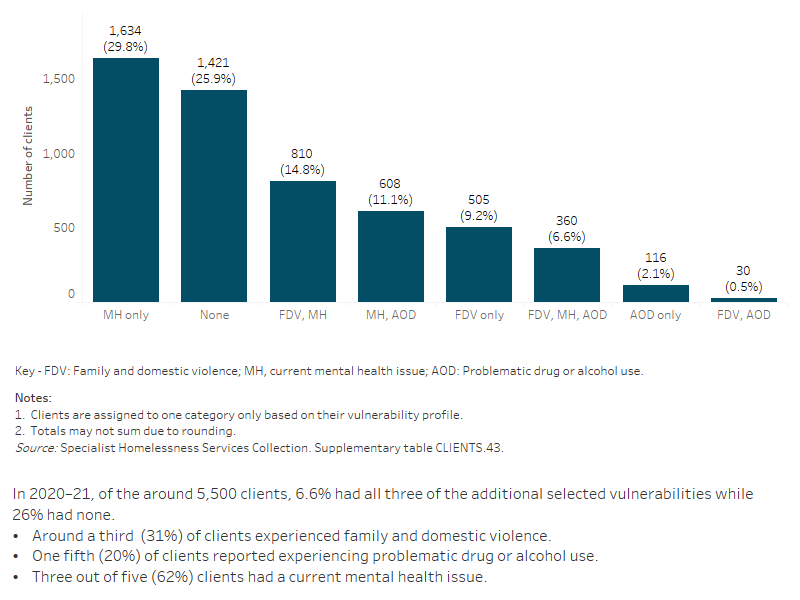
The National Disability Insurance Scheme (NDIS)
The National Disability Insurance Scheme (NDIS) supports people with a permanent and significant disability which affects their ability to take part in everyday activities. It is jointly governed and funded by the Australian and participating states and territory governments. The NDIS began its national rollout on 1 July 2016, and has been fully implemented to all eligible Australians as of 1 July 2020 (NDIS 2020). Further details about the NDIS are provided in the Technical notes.
NDIS participation indicator
The NDIS participation indicator was introduced into the Specialist Homelessness Services Collection (SHSC) from 1 July 2019. A participant in the NDIS is an individual who is receiving an agreed package of support through the National Disability Insurance Scheme. The NDIS question is asked of all clients at the start of support from a SHS agency. Data are not available for clients who only had support period(s) starting before 1 July 2019.
NDIS and COVID-19
The National Disability Insurance Agency (NDIA) provides information about coronavirus-19 (COVID-19) specifically relevant to people with disability including how NDIS participants can receive support during the COVID-19 pandemic. The NDIA website provides information including Disability Gateway. updates and advice, frequently asked questions, accessible resources, participant fact sheets as well as other information. For addition details see Coronavirus (COVID-19) information for people with disability (NDIS Quality and Safeguards Commission 2021).
National Disability Insurance Scheme (NDIS) participants
A person can be identified as being a SHS client with severe or profound disability but not be a participant in the NDIS. This may be because the client did not meet the NDIS eligibility criteria, has not applied for the NDIS or has a pending application. These clients may still be receiving disability support under the National Disability Agreement (NDA) (NDIS 2021). In 2020–21, of the 7,000 SHS clients with severe or profound disability 2,100 (35%) indicated that they received an agreed package of support through the NDIS.
For further information regarding the number of SHS clients receiving support through the NDIS see Clients, services and outcomes.
Service use patterns
The length of support clients with severe or profound disability received increased in 2020–21 to a median of 87 days, up from 65 days in 2016–17. The average number of support periods per client however has remained consistent over time from an average of 2.4 support periods per client in 2018–19 to 2020–21. The proportion of clients receiving accommodation decreased from 39% in 2016–17 to 37% in 2020–21, while the median number of nights accommodated increased from 50 in 2018–19 to 57 in 2019–20 and 61 in 2020–21 (Supplementary table CLIENTS.44).
New or returning clients
The episodic or cyclic nature of homelessness can be explored by determining whether clients with severe or profound disability were new to SHS agencies, or returning clients. In 2020–21, 66% (almost 4,600 clients) of SHS clients with severe or profound disability had received SHS assistance at some time since the collection began in July 2011 (Supplementary table CLIENTS.38), higher than all SHS clients (61%) (Supplementary table CLIENTS.2).
Main reasons for seeking assistance
In 2020–21, for SHS clients with severe or profound disability the most common reasons for seeking assistance were (Supplementary tables DIS.4 and DIS.5):
- Housing crisis (24% or almost 1,700 clients); most common for clients experiencing homelessness (29% or 860 clients) and those at risk of homelessness (21% or around 770 clients).
- Family and domestic violence (19% or 1,300 clients).
- Inadequate or inappropriate dwellings conditions (15% or around 1,100 clients).
Services needed and provided
The most common reasons clients with severe or profound disability sought SHS assistance were housing-related. Other common reasons were for financial reasons and for advice and advocacy (Supplementary table DIS.2) (Figure DIS.3).
Figure DIS.3: Clients with disability, by services needed and provided, 2020–21
This interactive stacked horizontal bar graph shows the services needed by clients with severe or profound disability and their provision status. Long term housing was the most needed service and the least provided. Assistance to sustain tenancy or prevent tenancy failure or eviction was the most provided service.
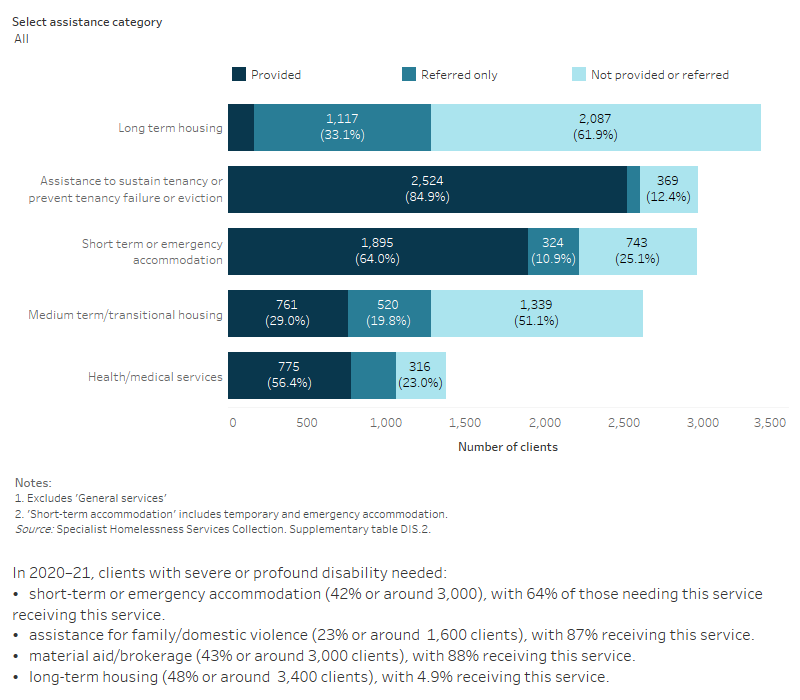
Other services that were needed by clients with severe or profound disability included (Supplementary tables CLIENTS.23 and DIS.2) (Figure DIS.3):
- One in 5 clients (20% or around 1,400) needed health/medical services and 77% (or around 1,100) of clients with these identified needs either received the services or were referred elsewhere for services.
- About one-quarter of clients (23% or 1,600) needed assistance for family and domestic violence and 87% (or about 1,400) of clients with these identified needs were provided with assistance and 3.4% (55 clients) were referred.
- Clients with severe or profound disability were more likely to need transport (21% or almost 1,500 clients), assistance with challenging social/behavioural problems (19%) and assistance for trauma (16%) than the general SHS population (15%, 12% and 13% respectively).
Housing situation and outcomes
Outcomes presented here highlight the changes in clients’ housing situation between the start and end of support. Data is limited to clients who ceased receiving support during the financial year – meaning that their support periods had closed and they did not have ongoing support at the end of the year.
Many clients had long periods of support or even multiple support periods during 2020–21. They may have had a number of changes in their housing situation over the course of their support. These changes within the year are not reflected in the data presented here, rather the client situation at the start of their first period of support during 2020–21 is compared with the end of their last period of support in 2020–21. A proportion of these clients may have sought assistance prior to 2020–21, and may again in the future.
SHS agencies were able to assist many clients secure or maintain housing, reducing the experience and risk of homelessness among clients with severe or profound disability. At the start of SHS support, more clients with severe or profound disability were at risk of homelessness (almost 2,400 or 58%) than experiencing homelessness (1,800 or 42%), similar to all clients (56% and 44% respectively); more clients with severe or profound disability (1,500 or 35%) were in private housing than any other housing situation.
For clients with severe or profound disability in 2020–21, around 1,800 clients (42%) were experiencing homelessness at the start of support; 800 (19%) were in short term temporary accommodation. By the end of support, there were fewer clients with severe or profound disability experiencing homelessness (1,200 clients or 30%) and 64% of clients were housed, with most clients living in private rental accommodation (1,500 clients or 38%) (Figure DIS.4).
Figure DIS.4: Housing situation for clients with disability with closed support, 2020–21
This interactive Sankey diagram shows the housing situation (including rough sleeping, couch surfing, short term accommodation, public/community housing, private housing and Institutional settings) of clients with sever or profound disability with closed support periods at first presentation and at the end of support. The diagram shows clients’ housing situation journey from start to end of support. Most started and ended support in private housing.
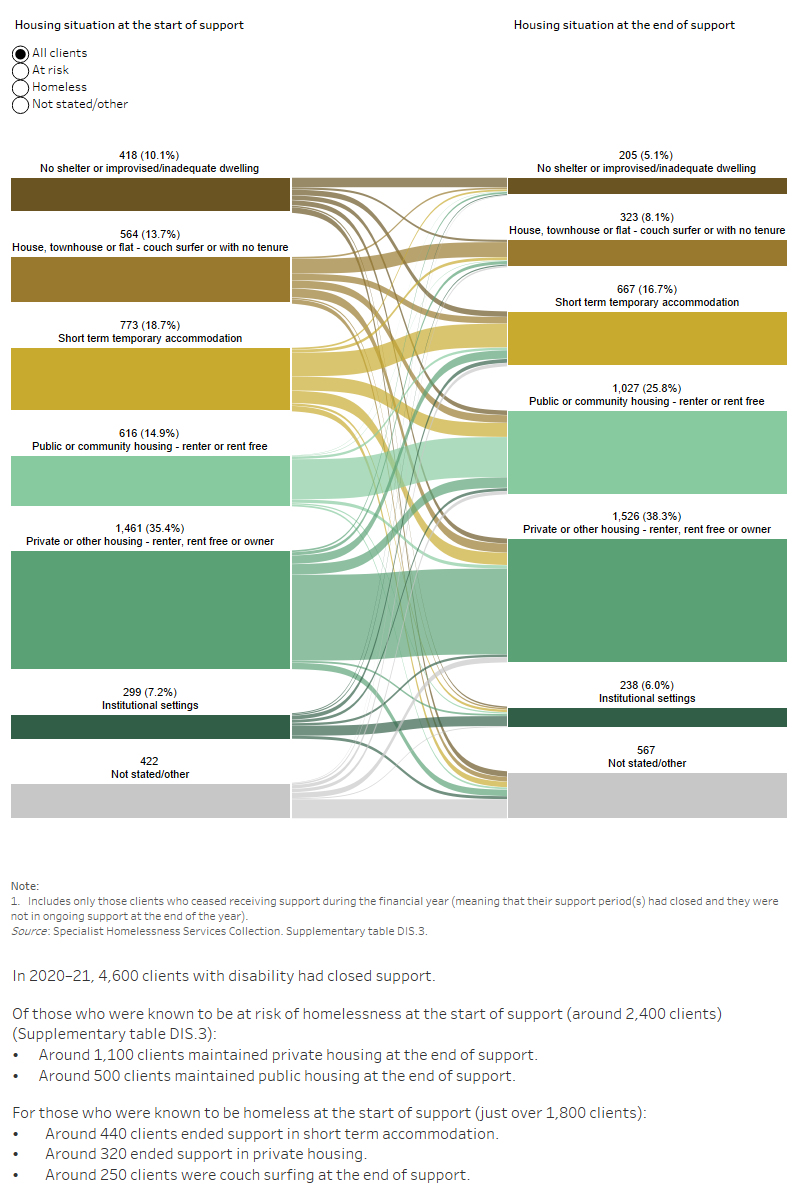
For more information on people with disability, see People with disability in Australia, AIHW.
ABS (Australian Bureau of Statistics) 2019. Disability, Ageing and Carers, Australia: Summary of Findings, 2018. ABS cat. no. 4430.0. Canberra: ABS.
ABS 2018. Census of population and housing: Estimating homelessness, 2016. ABS cat. no. 2049.0. Canberra: ABS.
AIHW (Australian Institute of Health and Welfare) 2020. People with disability in Australia. Cat. No. DIS 72. Canberra: AIHW.
Beer A, Baker E, Lester L, & Lyrian D 2019. The relative risk of homelessness among persons with a disability: New methods and policy insights. International Journal of Environmental Research and Public Health, vol. 16, issue 22: 1-12
Beer A, Baker E, Mallett S, Batterham D, Pate A, & Lester, L 2012. Addressing homelessness amongst persons with disability: Identifying and enacting best practice. FaHCSIA National Homelessness Research Project. Project 1-EFBLTW. Adelaide: Centre of Housing, Urban and Regional Planning.
COAG (Council of Australian Governments) 2011. National Disability Strategy 2010–2020. Canberra: Commonwealth of Australia.
National Disability Insurance Scheme (NDIS) 2020. Delivering the NDIS: roll-out complete across Australia as Christmas and Cocos Islands join world-leading scheme. Viewed 7 September 2021.
NDIS 2021. Understanding the NDIS. Viewed 7 September 2021.
NDIS Quality and Safeguards Commission 2021. Coronavirus (COVID-19) information for people with disability. Viewed 30 August 2021.
Royal Commission 2021. Royal Commission into the Violence, Abuse, Neglect and Exploitation of People with disability. Viewed 20 September 2021.


